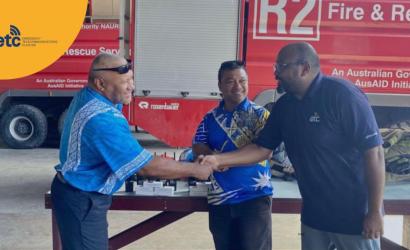Nauru
Nauru, the world’s third smallest country by land area, is a single-island nation in the central Pacific Ocean with a total area of just 21 km² and a coastline of 30 km. Despite its small size, Nauru is the most densely populated country in Oceania, with limited land for agriculture, infrastructure, and safe relocation in the face of climate threats. The country’s geographic isolation and economic dependence on external aid and phosphate mining make it vulnerable to environmental and economic shocks.
Nauru faces increasing risks from climate change, including sea level rise, coastal erosion, and extreme weather events such as droughts and king tides. These hazards threaten freshwater availability, food security, and critical infrastructure, particularly in low-lying coastal areas. The country’s limited natural resources and high reliance on imports further compound its vulnerability. To address these challenges, Nauru has adopted national strategies such as the National Framework for Climate Change and Disaster Risk Reduction and the Nauru Sustainable Development Strategy. These frameworks aim to strengthen resilience through integrated planning, sustainable resource management, and improved disaster preparedness.
Telecommunications infrastructure in Nauru is being developed under the National Digital Transformation Strategy 2025–2030, which aims to expand high-speed broadband networks across the country. Under the Department of Information and Communications Technology, investments focus on resilient systems for secure data and integrated e-government solutions, with support from the International Telecommunication Union (ITU) and SDG Fund, working towards a digitally-transformed nation.
In August 2025, Nauru has seen a significant stride in improving telecoms infrastructure with the landing of the East Micronesia Cable System in its shores. This first-ever undersea cable forms part of the cable system that will link Nauru, FSM, and Kiribati with transpacific submarine cables to the US, Australia, Japan, and Southeast Asia, enabling high-speed, high-quality, reliable and more secure communications for residents, businesses and governments in Nauru.
ICT Profile
National Emergency Services (NES) / National Disaster Risk Management Council
Ministry of Information, Communications and Technology (ICT). This ministry oversees the Department of ICT, which is responsible for all government communications and information systems.
Nauru Communications Authority. It was established under the Communications and Broadcasting Act 2018.
12,025
The ETC is not activated in Nauru. The ETC is focused on preparedness activities in Pacific Island countries under its Pacific Emergency Preparedness and Response (EPR) project, led by WFP.
Nauru, the world’s third smallest country by land area, is a single island nation in the central Pacific Ocean with a total area of just 21 km² and a coastline of 30 km. Despite its small size, Nauru is the most densely populated country in Oceania, with limited land for agriculture, infrastructure, or relocation in the face of climate threats. The country’s geographic isolation and economic dependence on external aid and phosphate mining make it particularly vulnerable to environmental and economic shocks.
Nauru faces increasing risks from climate change, including sea-level rise, coastal erosion, and extreme weather events such as droughts and king tides. These hazards threaten freshwater availability, food security, and critical infrastructure, particularly in low-lying coastal areas. The country’s limited natural resources and high reliance on imports further compound its vulnerability. To address these challenges, Nauru has adopted national strategies such as the National Framework for Climate Change and Disaster Risk Reduction and the Nauru Sustainable Development Strategy (NSDS These frameworks aim to strengthen resilience through integrated planning, sustainable resource management, and improved disaster preparedness.
Telecommunications infrastructure in Nauru is being developed under the National Digital Transformation Strategy 2025–2030, which aims to expand high-speed broadband networks across the country. The government, through its Department of ICT, is investing in resilient internet and network systems to support public services, schools, and health clinics, with a focus on secure data transfer and integrated e-government solutions.
The National Disaster Risk Management Office (NDRMO) leads and coordinates all emergency response activities.
Australian Dollar (AUD)
0
87
9.96
87
52.6%
98%
National Disaster Risk Management Act 2016
-This is the primary legal framework for disaster management in Nauru. Key features include:
1. Establishment of the National Disaster Risk Management Council (NDRMC) to advise the Cabinet.
2. Declaration of a State of Disaster under Section 26, allowing for emergency powers and coordination.
Guiding principles include:
1. Risk reduction;
2. Community engagement;
3. Coordination between government and stakeholders; and
4. Integration with sustainable development goals.
Communications and Broadcasting Act 2018
-This is the primary legislation governing telecommunications in Nauru. It replaced the 2017 Act and established the Nauru Communications Authority. Key highlights include:
1. Licensing & Regulation: All service providers must be licensed. The Authority can set tariffs and enforce compliance.
2. Spectrum Management: The Authority manages radio frequencies and resolves interference issues.
3. Consumer Protection: Ensures confidentiality, fair pricing, and service quality.
4. Infrastructure Access: Grants providers rights to access property for installing telecom infrastructure.
5. Emergency Provisions: Special powers during national emergencies.
6. Content Regulation: Includes standards for broadcasting and internet content filtering (e.g., child protection).
No Formal Unmanned Aircraft Vehicle (UAV) Regulations
-According to the Pacific Aviation Safety Office (PASO), drone operations are not formally regulated in Nauru.
In the absence of national laws, operators are advised to follow International Civil Aviation Organization (ICAO) guidelines, especially the ICAO UAS Toolkit.
ICAO Recommendations (Applied in Nauru)
1. Operators should adhere to the following general rules:
2. Keep drones within visual line of sight.
3. Avoid flying above 150 meters (490 feet).
4. Do not fly within 50 meters of people, vehicles, or property.
5. Stay at least 8 km (5 miles) away from airports.
Obtain a permit if:
1. The drone weighs more than 25 kg.
2. It is used for commercial or research purposes.
